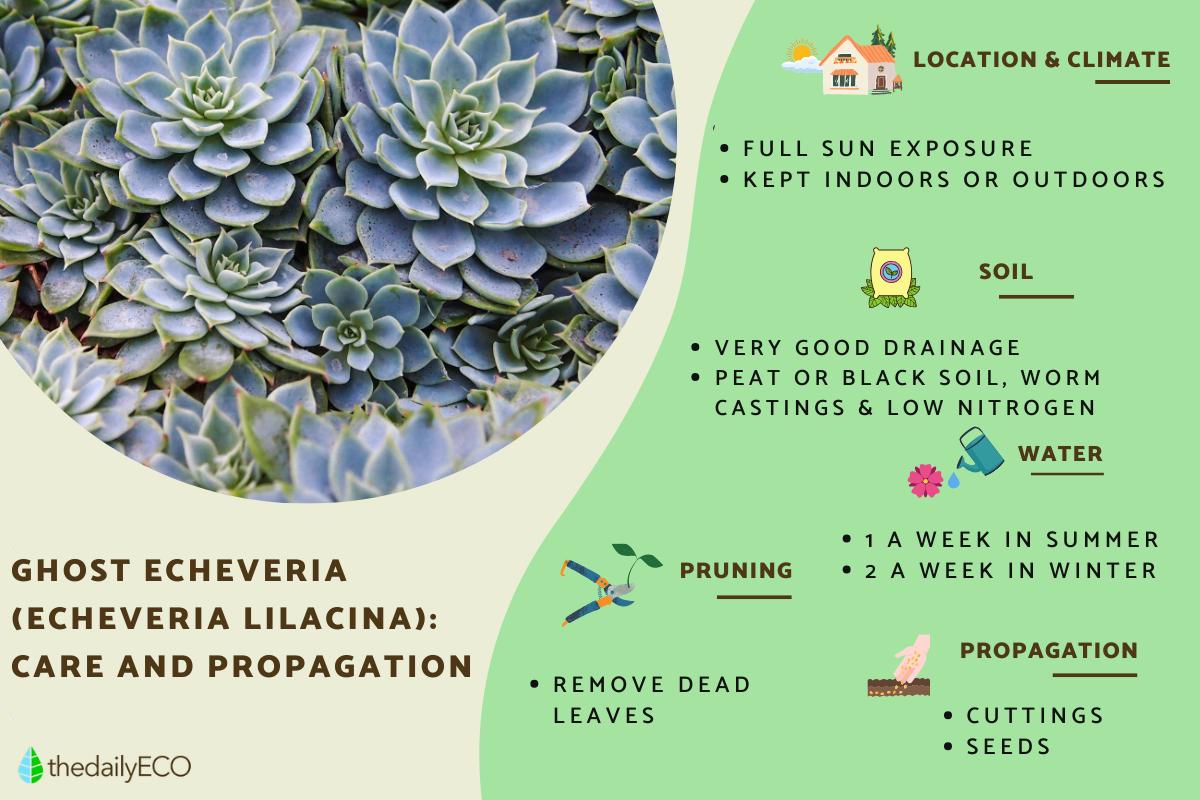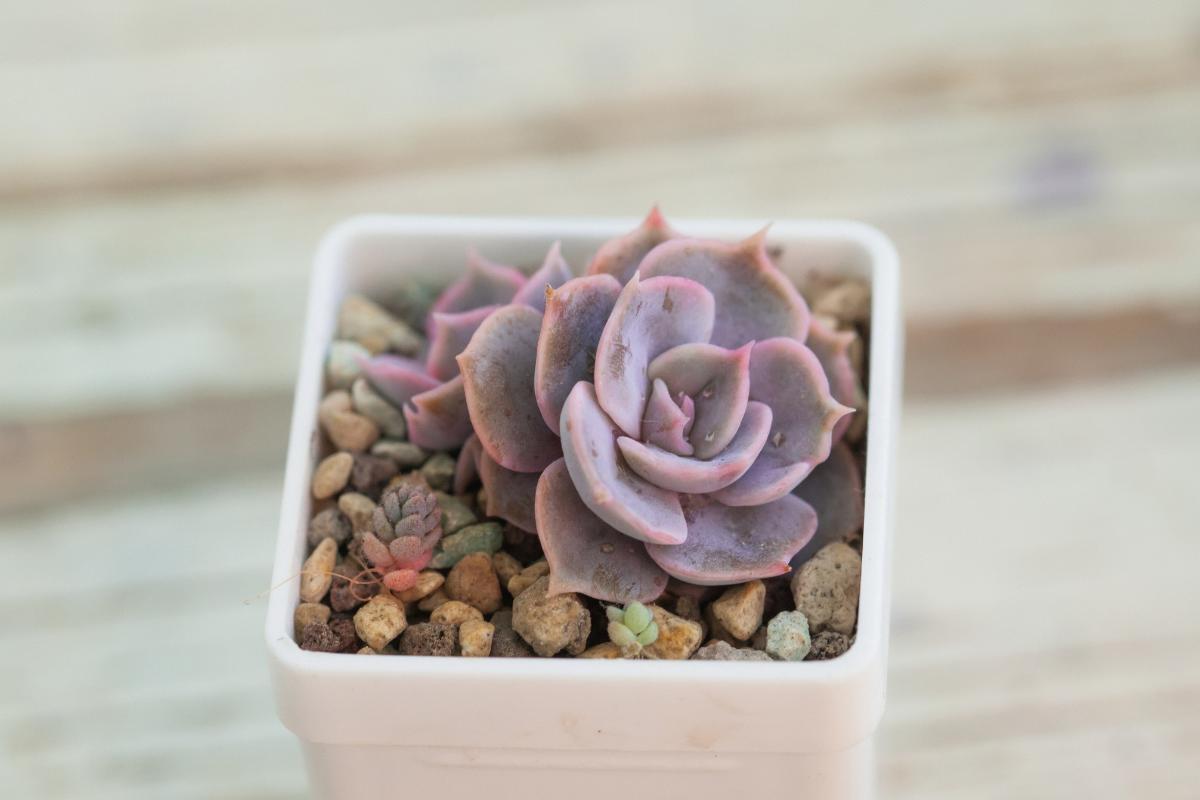Ghost Echeveria Plant Care - Echeveria Lilacina


Also known as the Mexican hens and chicks plant, the ghost echeveria (Echeveria lilacina) is a beautiful succulent that requires full sun, low watering, soil with good drainage and removal of withered leaves. Propagation is carried out by leaf cuttings.
Echeverias are succulents that are highly sought after for their attractive rosette shape and leaves in pastel tones. The ghost echeveria is highly prized for it color which is grayish with pink highlights. It is recommended for low-maintenance gardens or rock gardens. If you want to know more about ghost echeveria plant care, thedailyECO provides this complete care guide for Echeveria lilacina.
Ghost echeveria characteristics
There are many different types of succulent species, but they all have certain unique characteristics. The following are the characteristics of ghost echeveria plants:
- Echeveria lilacina has slightly flat leaves compared to other types of echeveria plant species. Each leaf is round in shape and has a pointed tip. These leaves have a slightly concave shape. They are considered succulents because they store water within themselves, making them fleshy to the touch.
- These leaves grow in a rosette and arranged in layers. They are usually grayish-green in color, but display shades of blue and pink during the colder months.
- They are covered by pruina, a dusty coating that gives it a whitish color a. It serves as a sunscreen for the plant to face the hours of maximum sun without getting burned. All manipulation of the plant must be done with great care and avoiding touching the pruina. This is because it comes off very easily and the fingerprint will be marked, affecting the aesthetics of the plant.
- The Echeveria lilacina flower grows from 6"/15 cm high floral stems, from which they hang like bells. They are coral in color and appear in late winter until spring. Discover more types of plants with bell flowers in our related article.
- Each rosette can be solitary or form colonies of several individuals that detach from the mother plant.
- It grows to 4"/10 cm in height, but it must be understood that it is slow growing. This size can remain for between 2 to 5 years of age.
- There are some cultivars which have been created by crossing species. Cultivars of ghost echeveria includeEcheveria lilacina variegata that has white leaves and Echeveria lilacina monstrosa with irregular leaves that have ruffle-like margins.
If you would like to grow ghost echeveria in your home, use the affiliate link below:

Ghost echeveria ight, temperature and location
As a type of succulent, the ghost echeveria plant does well in the sun. It preferably needs full sun, but can also be kept in partial shade as long as it receives a few hours of full light each day. If you keep it indoors, it is necessary to place it near a window so that it receives plenty of light.
Since it is native to semi-desert ecosystems in America, it needs a temperature between 18-27 ºC/64.4-80.6 18 ºF. It has been found to often attract butterflies, so it is a great addition to bring this type of life to gardens.
Ghost echeveria soil and fertilizer
Soil is key to keeping Echeveria lilacina in good condition. Since it is a succulent that stores water within its tissues. I if the soil holds water, the likelihood of them dying from rot will increase.
To do this, a substrate mixture is prepared for succulents or cacti. They are taken with equal parts of worm castings, peat and a porous material that can be vermiculite, tepojal or lava rock for plants.
Learn how to make your own worm castings at home with our DIY guide.

Ghost echeveria watering
In the growing season of spring and summer, watering must be moderate. The substrate must be allowed to dry between irrigations. The frequency depends on the climate of your area, although it is generally watered once a week outdoors and every two weeks indoors. In autumn and winter, watering is reduced to every two weeks since there is no growth. Add a little water at a time and stop if you see the leaves wilting.
Ghost echeveria does not tolerate waterlogging, so it should not be overwatered. So that the water does not stagnate, it is important to provide the aforementioned substrate and check its moisture before irrigating. Only water when the first inch of soil is dry. It is best watered by immersion irrigation using a plant pot saucer. If watered above the rosette, water can become trapped between the leaves, causing rot and death of the plant.
Ghost echeveria pruning
Leaves that are aging at the bottom should be removed to prevent mold growth. For the other leaves, the ghost echeveria does not need pruning due to its compact structure. If a leaf were to come off, don't worry. There is a great opportunity to take advantage of it and reproduce it to create more echeverias.
Learn more about pruning with our guide to black spots on plant leaves.

Ghost echeveria propagation
The easiest way to propagate the ghost echeveria plant is through cuttings. This is best performed during the spring. You only need to cut a leaf from your plant and place it in a bed of worm castings. A new plant will sprout here, as long as you have regular watering
The second option to reproduce this plant is through seeds which you can obtain in specialized stores. Since propagation can be a little tricky, it is best to do it with a pre-rooted plant like the one you can buy in the link shared above. If you do use seeds, you will need to place it in worm castings and ensure it is sufficiently covered.
Ghost echeveria takes a long time to germinate, with some needing up to 3 months. To facilitate the process, a plastic dome can be placed to retain moisture and heat. Remember to place an identifier so that you do not forget your plant for a long time.
Now that you know how to care for Echeveria lilacina, discover how to care for other members of this genus with our guide to Echeveria pulvinata plant care.
If you want to read similar articles to Ghost Echeveria Plant Care - Echeveria Lilacina, we recommend you visit our Plant care and cultivation category.
- Kondo, Y., Kondo, T. (2022). Succulents Made Easy: A Beginner's Guide (Featuring 200 Varieties). Japan: Tuttle Publishing.
- Royal Horticultural Society. (n.d.). Echeveria lilacina. Retrieved from: https://www.rhs.org.uk/plants/284418/echeveria-lilacina/details
- Nah, G., Jeong, J. R., Lee, J. H., Soh, S. Y., & Nam, S. Y. (2022). The complete chloroplast genome of Echeveria lilacina Kimnach & Moran 1980 (Saxifragales: Crassulaceae). Mitochondrial DNA Part B, 7(5), 889-891.








